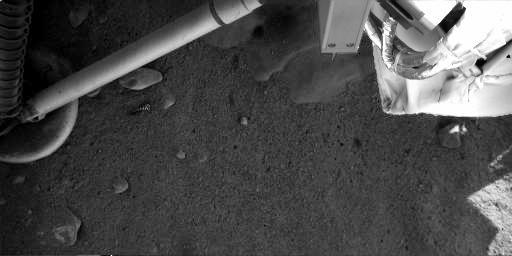Emily Lakdawalla • May 30, 2008
Phoenix sol 5 roundup
Today was the last of the daily press briefings following Sunday's landing of the Phoenix mission; they said they won't have another one until "at least Tuesday." Which is good for me, because I really need a break; and on Monday and Tuesday I'm attempting to give two remote presentations to the upcoming American Astronomical Society / Astronomical Society of the Pacific meetings taking place in St. Louis. At least one of those might be on Ustream; see Star Stryder for more on that.
My various Google gadgets tell me that the weather at the Phoenix landing site yesterday had the same minimum and maximum temperatures as the last several days, but that there is more dust; and that, as I write this at 2 pm my time, it's only 10:30 am at the Phoenix site. Phoenix' days are beginning to slip later and later. Pretty soon, its afternoon downlink of images will no longer happen at a time of day when I am still awake; instead of checking for new images before I go to bed, I'll have to get up and look for them first thing in the morning.
I had a tough time following today's press briefing because I attempted to watch it online but the feed quality was very poor. I'll do my best to summarize what I could catch (with some help filling in the gaps from the folks at unmannedspaceflight.com).
They're still in the instrument characterization phase, in which they're checking out the performance of their instruments, and it seems that they've hit their first snag. One of the instrument teams, for the Thermal and Evolved Gas Analyzer or TEGA, is working on an anomaly: TEGA head William Boynton reported that it looks like they have an intermittent short circuit in one part of their instrument, the ion source. He said, "We are working on some diagnostic patches to send up in the next few days. We are optimistic that we have some workarounds that will allow us to operate the instrument with nearly the full capabilities." TEGA was probably going to be the first instrument to receive a soil sample, but they probably won't want to touch any soil until they've figured out how to work around the short circuit, so it appears that the Microscopy, Electrochemistry, and Conductivity Analyzer (MECA) is now going to get the first chance at a sample.
They showed a graph of about 15 minutes' worth of data from the meteorological instrument, in which you could see that the sky started out clear but a dustier puff of air blew over the lander's head. That was neat, but even neater is that in the time right before they took that data, the camera shot an animation sequence of the lidar's laser beam turning on. Here's my animation of that data. (This was Doug Ellison's idea. Now, though, as I write this, I notice that NASA just posted a version of this animation. I'm posting my version anyway, since I went to the trouble of making it!)

NASA / JPL / UA / animation by Emily Lakdawalla
Phoenix' lidar beams into space
On sol 3, Phoenix' camera watched as the meteorological instrument beamed a laser toward the sky to examine the quantity of dust in the atmosphere. The laser light source is within the small cylinder at the center of the animation, and its light can be seen scattering off the interior of the cylinder as it turns on and off.Another topic of conversation at today's press briefing was this view of the terrain under the lander, captured by the robotic arm camera.

NASA / JPL / UA
Robotic arm camera peeks under the Phoenix lander
On sol 4, Phoenix used its robotic arm to examine one of the lander footpads, which cannot be imaged by the mast-mounted camera. In the same observation, it observed a strange platy texture in the ground below Phoenix. It is not yet known whether these plates are ice or rock. Their smoothness might suggest ice, but they look superficially similar to "duricrust" exposed at the Viking 2 landing site.The Time is Now.
As a Planetary Defender, you’re part of our mission to decrease the risk of Earth being hit by an asteroid or comet.
Donate Today

 Explore Worlds
Explore Worlds Find Life
Find Life Defend Earth
Defend Earth



